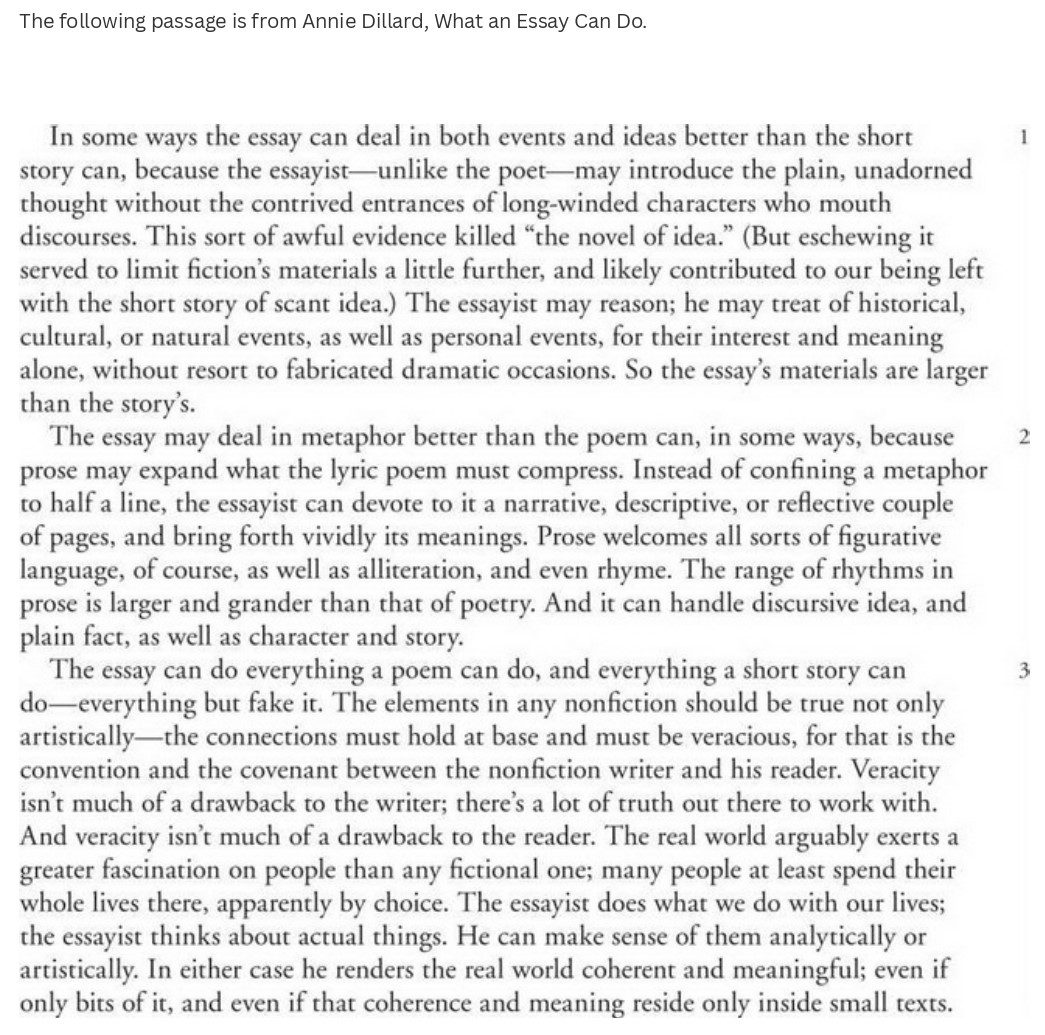
Dillard makes sure the reader's attention doesn't wander by beginning each paragraph with the phrase "the essay." It also offers the passage's structural underpinning. There is no use of the passive voice. The author does not share any personal experiences with her audience, and the previous phrase is an example of passive voice.
In the first two sentences, the author blames “contrived entrances” for killing “the novel of idea.” She supports this in the next to the last sentence in paragraph 1 by criticizing “fabricated dramatic occasions.” Both of these examples point to the artificial construct of fiction.
The opening paragraph features two significant cause-and-effect situations, which is the author's main rhetorical device. Sentences 1-3 contain the first, and sentences 22 and 23 contain the second.
The first of the essayist's two phrases explains what he does, which is to think. His thought process and writing style are shown in the second sentence. Dillard emphasizes the importance of each of these arguments in equal measure by phrasing them in two different phrases.
Any other choice rejects the correct meaning of antecedent/referent, which can only be determined by a careful study of the sentence and understanding of how to find antecedents.
The contrast and comparison between prose and poetry in the second paragraph help to make its point clearly. The paragraph doesn't use any of the other tactics.
The essay's subject is Dillard. Her stance is one of unwavering adherence to its structure and purpose. She never criticizes the essay or the essayist, and she never discusses innovations or how the structure of the essay has changed. Dillard creates art. Her position on the essay form is not made clear by this classification, though.
Advertisement
The selection of A is simple since it is made possible by understanding what parallel structure is and being able to identify it. "Even if... even if..."
With the author's usage of the words "connections," "covenant," "veracity," and "truth" in sentences 1-3 of paragraph 3, there is only one answer that fits this diction: B.
Only option E has two adjectives that ARE BOTH appropriate to describe the author's tone in this text. The essay's goal is to inform/explain both the reader and the essayist about how the essay works. This serves as evidence in favor of the choice of E. The writer's consideration of the other literary genres demonstrates his or her confidence.
The day is over for our class if you choose option E. Seriously, it is clear from the speech that the speaker is both horrified by how women are treated and insists that women's rights be respected. There is no other option that fits either description.
The answer to this question is given in the fifth sentence of the first paragraph. The student should notice that Stone argues in these two paragraphs that both blacks and women are implicitly treated equally since they are not educated.
The learner will notice that it is reasonable to infer that the speaker does not hold teaching in high regard if they pay close attention to the sixth statement in paragraph 1.
Each of these passages is significant to the speech. But only one plays the part of being in charge of all thought. The alternative options are subtopics.
Advertisement
In paragraph 1, the first six phrases provide anecdotal evidence. Specifically, the second half of paragraph 2 contains a straight citation. The fourth and fifth sentences of paragraph 1 use facts, and the seventh sentence of paragraph 2 uses an emotional appeal. The speech does not use any personal attacks.
Stone wants women to fight back against sexism by standing up for themselves. This remark, however, implies that she must genuinely ensure that women are mistreated until they can no longer take it. Only then does Stone observe their willingness to assert their rights.